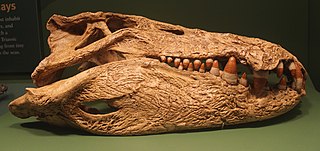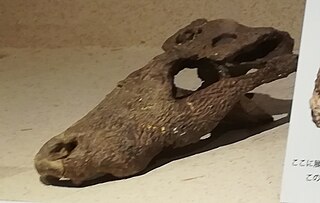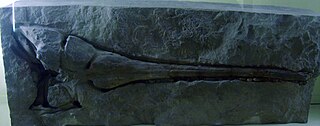
Ceratosuchus is an extinct genus of alligatorine crocodylian from latest Paleocene rocks of Colorado's Piceance Basin and earliest Eocene rocks of Wyoming's Bighorn Basin in North America, a slice of time known as the Clarkforkian North American Land Mammal Age. Like its modern relatives, Ceratosuchus was a swamp-dwelling predator. It is named for the pair of flattened, triangular bony plates that extend from the back of its head.

Mahajangasuchus is an extinct genus of crocodyliform which had blunt, conical teeth. The type species, M. insignis, lived during the Late Cretaceous; its fossils have been found in the Maevarano Formation in northern Madagascar. It was a fairly large predator, measuring up to 3 m (9.8 ft) with a weight up to 360 kg (790 lb).

Mourasuchus is an extinct genus of giant, aberrant caiman from the Miocene of South America. Its skull has been described as duck-like, being broad, flat and very elongate, superficially resembling Stomatosuchus from the Late Cretaceous.
Procaimanoidea is an extinct genus of alligatorid from the Eocene of North America. It was named posthumously in 1946 by Charles W. Gilmore; the type species is P. utahensis, from the Uintan of Utah. It is based on USNM 15996, a nearly complete skull and partial left hind leg. A second species, P. kayi, was named in 1941 by C.C. Mook as a species of Hassiacosuchus, for remains from the Bridgerian of Wyoming. It was reassigned to Procaimanoidea in 1967 by Wassersug and Hecht. Procaimanoidea was a small alligatorid, and slightly heterodont, the last four teeth on each side of the jaws having blunt tips.

A caiman is an alligatorid belonging to the subfamily Caimaninae, one of two primary lineages within Alligatoridae, the other being alligators.

Necrosuchus is an extinct genus of caiman from modern day Argentina that lived during the Paleocene epoch. It inhabited the fluvio-lacustrine environment of the Patagonian Salamanca Formation.

Allognathosuchus is an extinct genus of alligatorine crocodylian with a complicated taxonomic history. It was named in 1921.

Navajosuchus is an extinct genus of alligatorine crocodylian. Its fossils have been found in the Paleocene-age Nacimiento Formation of the San Juan Basin, New Mexico. It was named in 1942 by Charles C. Mook, and the original type species was N. novomexicanus. N. novomexicanus was based on AMNH 5186, a partial skull collected in 1913. Later research showed that Navajosuchus novomexicanus was the same as the earlier-named Allognathosuchus mooki. However, A. mooki does not belong to the genus Allognathosuchus, and so the name of the crocodilian becomes Navajosuchus mooki. Under whichever name is used, this animal would have been a generalized predator of the Nacimiento floodplains. It was the most common Nacimiento Formation crocodilian, found in both the Puercan and Torrejonian faunal assemblages.
Eutretauranosuchus is an extinct genus of goniopholidid crocodyliform. E. delfsi is the only known species within the genus.

Brachychampsa is an extinct genus of alligatoroid, possibly a basal caiman. Specimens have been reported from New Mexico, Colorado, Wyoming, Montana, North and South Dakota, New Jersey, and Saskatchewan, though only those from Montana, Utah, and New Mexico are based on material sufficient to justify the referral. One specimen has been reported from the Darbasa Formation of Kazakhstan, although the species status is indeterminate for the fossil. The genus first appeared during the late Campanian stage of the Late Cretaceous and became extinct during the late Maastrichtian stage of the Cretaceous. Brachychampsa is distinguished by an enlarged fifth maxillary tooth in the upper jaw.
Chrysochampsa is an extinct genus of alligatorine. Fossils have been found from the Golden Valley Formation of North Dakota and date back to the Wasatchian regional North American faunal stage of the early Eocene. The genus has been proposed to be synonymous with Allognathosuchus at times, but it is now generally accepted that Chrysochampsa is distinct from all other alligatoroids and is its own taxon.
Eogavialis is an extinct genus of eusuchian crocodylomorph, usually regarded as a gavialoid crocodylian. It superficially resembles Tomistoma schlegelii, the extant false gharial, and consequently material from the genus was originally referred to Tomistoma. Indeed, it was not until 1982 that the name Eogavialis was constructed after it was realised that the specimens were from a more basal form.
Eothoracosaurus is an extinct genus of eusuchian crocodylomorphs which existed during the Late Cretaceous period. Thoracosaurs in general were traditionally thought to be related to the modern false gharial, largely because the nasal bones contact the premaxillae, but phylogenetic work starting in the 1990s instead supported affinities within gavialoid exclusive of such forms. Even more recent phylogenetic studies suggest that thoracosaurs might instead be non-crocodilian eusuchian.
Listrognathosuchus is an extinct genus of alligatoroid crocodilian. Fossils date back to the middle Paleocene epoch. In 1997, the generic name replaced that of Leidyosuchus for the species L. multidentatus. "L." multidentalis was first described by Charles Mook in 1930 on the basis of the holotype AMNH 5179, consisting of a partial vertebral column, mandible, partial left ilium, and left tibia, found from a locality in Torrejon Arroyo, New Mexico.

Pholidosaurus is an extinct genus of neosuchian crocodylomorph. It is the type genus of the family Pholidosauridae. Fossils have been found in northwestern Germany. The genus is known to have existed during the Berriasian-Albian stages of the Early Cretaceous. Fossil material found from the Annero and Jydegård Formations in Skåne, Sweden and on the island of Bornholm, Denmark, have been referred to as a mesoeucrocodylian, and possibly represent the genus Pholidosaurus.
Prodiplocynodon is an extinct genus of basal crocodyloid crocodylian. It is one of the only crocodyloids known from the Cretaceous and existed during the Maastrichtian stage. The only species of Prodiplocynodon is the type species P. langi from the Lance Formation of Wyoming, known only from a single holotype skull lacking the lower jaw.

Stangerochampsa is an extinct genus of globidontan alligatoroid, possibly an alligatorine or a stem-caiman, from the Late Cretaceous of Alberta. It is based on RTMP.86.61.1, a skull, partial lower jaws, and partial postcranial skeleton discovered in the late Campanian–early Maastrichtian-age Horseshoe Canyon Formation. Stangerochampsa was described in 1996 by Wu and colleagues. The type species is S. mccabei. The generic name honors the Stanger family, the owners of the ranch where the specimen was found, and the species name honors James Ross McCabe, who discovered, collected, and prepared it. Stangerochampsa is described as "small to medium–sized"; the type skull is 20.03 centimetres (7.89 in) long from the tip of the snout to the occipital condyle, and is 13.0 centimetres (5.1 in) wide at its greatest, while the thigh bone is 14.2 centimetres (5.6 in) long. It had heterodont dentition, with large crushing teeth at the rear of the jaws.

Tsoabichi is an extinct genus of caimanine crocodylian. Fossils are known from the Green River Formation in Wyoming, and date back to the Ypresian stage of the Eocene. The genus was named and described in 2010 by paleontologist Christopher A. Brochu, with the type species being Tsoabichi greenriverensis. According to the current understanding of caiman evolutionary relationships, Tsoabichi is a basal member of Caimaninae and may have evolved after caimans dispersed into North America from northern and central South America, their main center of diversity in the Cenozoic.

Globidonta is a clade of alligatoroids that includes alligators, caimans, and closely related extinct forms. It is defined as a stem-based clade including Alligator mississippiensis and all forms more closely related to it than to Diplocynodon. The group's fossil range extends back into the Late Cretaceous with early alligatoroids such as Albertochampsa and Brachychampsa. Extinct globidontans were particularly common in North America and Eurasia, and their modern range also includes South America.
Duerosuchus is an extinct genus of crocodilian. Remains have been found from Corrales del Vino in Zamora, Spain, and are middle Eocene in age. Duerosuchus is known from a single skull that is incomplete but otherwise well preserved, as well as a lower jaw, some osteoderms, and possibly some vertebrae.













